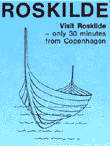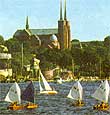| The Viking era lasted from the first half of the eighth century and the following three hundred years. The Vikings went north to Greenland, south to Baghdad, east to The Black Sea, and West to North America. They raided Paris and controlled the British Islands. In the booklet one of the most recognized experts on the Viking Era, the Director of the Viking Ship Hall Museum in the old Viking Capital Roskilde, Mr. Jan Skamby Madsen, in a brochure is telling as much as possible in so few pages about the three centuries of the Viking Era. Three Centuries that changed Denmark from being an almost unknown heathen area into a well-defined kingdom belonging to the European Christian Societies. The Viking shipFor good reason the ship has become a symbol of the Viking era. Seaworthiness and competent seamanship were the basis of the unification of the island realm of Denmark and a prerequisite of the numerous Viking cruises into other parts of the world. Contemporary west European sources provide scant information about ships and navigation but in the poetry of the later sagas the importance of the ship in daily life is treated more realistically. However, the allimportant clue to the shipbuilding of the time originates in archaeological finds. In Viking ship research the classics are the two Norwegian burial ships known as the Oseberg and the Gokstad which were unearthed in 1904 and 1880 on the west bank of the Oslo Fjord. They are magnificent royal ships, dating to the years 800 and 900, respectively. Burial by ship is known also in Denmark, at Ladby on the island of Funen. The Nordic shipbuilders went for lightness, strength and resilience in their vessels. The typical feature of the Viking ship is that it tapers at both ends with a smoothly curved transition between keel and stern. Ribs and planks ensuring the interior shoring are placed symmetrically abeam and regularly distributed lengthwise in the boat, while the exterior shell has clinkered planks overlapping each other along the edges. The ship was steered by a lateral rudder placed at the stern end in the right side of the navigation direction. The propelling force was sail and oars. The ship had one mast and one rectangular sail: a square sail. Speaking somewhat simply, the Viking ships can be divided into two categories: merchantmen and warships.
 The Viking Ship Museum at Roskilde Fjord. The span of the Viking ship construction was well demonstrated in the five Viking ships found at Skuldelev in Roskilde Fjord. The ships, which were no longer in service, had been filled with stones and scuttled by the mid1000s in order to close one of the lanes leading into the important commercial town of Roskilde. In 1962 a sheet piling was rammed down around the closure, the water was pumped out and the ships excavated. The five Skuldelev ships represent five different kinds of ship, two merchantmen, two warships and one ferry or fishing boat. The larger of the merchantmen was a hefty cargo vessel, 16.6 m long and 4.5 m abeam. It is probably the knarr type, an oceangoing freighter whose range included the North Atlantic to Iceland, Greenland and North America. The ship was built of fir, oak and lime. The building place may have been Norway as there was very little fir in Denmark during the Viking era. Its capacity was a cargo of 2025 tonnes and it was propelled by a rectangular sail of approx. 86 square metres. The smaller merchantman is an elegantly shaped oak vessel, l4 m long and 3.4 m abeam. The ship was wellsuited for navigation in the Danish waters and the Baltic Sea and its crew comprised four or five people. The sail must have measured 45 square metres, and the capacity was about five tonnes of goods. The smaller of the Skuldelev warships is built of oak, ash and fir. Its length is 17.5 metres and beam 2.5 metres, accommodating 13 pairs of oars and a crew of about 30 warriors. Along the gunwale a shield strap held the shields of the crew in place. The other warship found at Skuldelev is a long ship, approx. 30 metres in length and with a beam of 4.5 metres, with room for 30 pairs of oars and a crew of 60100 men. The ship is built of oak, and analyses of the wood have disclosed that it was probably built near Dublin in Ireland towards the end of the Viking age. The ship's rectangular sail measured about 150 square metres. The fifth ship found at Skuldelev is a small freighter, l2 metres long, 2.5 metres abeam. It was built of fir planks and may have served as a fishing boat or a ferry. The navigation abilities of the Viking ships have been much discussed for many years. To investigate this problem more closely three identical copies of three of the Skuldelev boats have over the past decade been built under the supervision of specialised scientists. In 1983, near Ålesund in Norway, a copy was launched of the larger merchantman: the knarr . The copy, named Saga Siglar, set out in 1984 on a circumnavigation of the globe with the first part of the voyage following the ancient Viking route across the North Atlantic to Iceland and Greenland. The navigation tests done so far with the two copies of the
merchantmen from Skuldelev have provided us with a good background
for evaluating the sailing qualities of the freighters. On the
basis of the tests it can be concluded that already by the Viking
age a navigation standard had been achieved which fully matched
that of the smaller merchantmen at the end of the sailing ship era
shortly before World War I.
|

The Viking Ship Museum
a workshop of constructive archaeology.

Roskilde Cathedral
Royl Mausoleum for the past 800 years.

Environs of Roskilde
The Village of Antiquity
historical-archeological research centre at Lejre wirh reconstructed houses and live workshops.